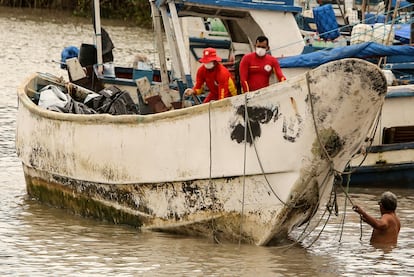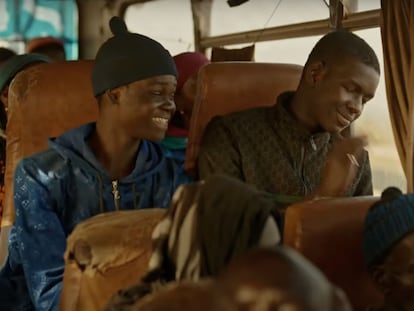Boat drifts to Brazil with nine dead migrants from Mauritania and Mali
The Federal Police were able to determine the victims’ origin thanks to their documentation and belongings, and are now trying to identify the bodies


Nine decomposed bodies were found Saturday on a boat that drifted to the coast of Brazil. On Tuesday, Brazil’s Federal Police reported in a statement that signs indicate that “the victims were migrants from the African continent, from the region of Mauritania and Mali.”
The boat was located by fishermen off the coast of the Brazilian state of Pará, on the other side of the Atlantic, 2,600 miles from the Mauritanian coast. After towing the boat ashore to the municipality of Bragança, Brazilian police officers inspected it on Monday and, thanks to the documentation and belongings found with the bodies, were able to identify its origin.
It is likely that the boat is one of the many that make the dangerous journey to Europe. Many set sail from Mauritania towards Spain’s Canary Islands, where there has been a surge in migrant boats. So far this year, more than 14,000 African migrants have arrived in the Spanish archipelago via this route — six times more than in the same period in 2023.
The circumstances of the boat’s discovery in Brazil suggest that it became adrift for an unknown reason, and dragged the migrants away from their intended destination. Propelled by the currents, the boat crossed the Atlantic, and the migrants died in their attempt to reach Europe. Brazilian authorities have not ruled out that people of other nationalities may be among the victims. They have also not indicated the gender or age of the deceased.
The Federal Police and the Scientific Police of the state of Pará are now working on forensic analyses to determine the victims’ identities, the cause of death and how long ago they died. A task that has been made difficult by the advanced state of decomposition of the bodies. The police statement adds that eight of the bodies were found inside the boat and one of them was floating in the water nearby, suggesting that the victim belonged to the same group.
Similarities with Mauritanian fishing boats
From the beginning, Brazilian authorities suspected that the deceased were of foreign origin. They worked on the hypothesis that the victims were African migrants who drifted from their route to Europe or were Haitians who were trying to arrive in Brazil. After examining the first photos taken of the boat, specialists in the Canary Islands’ immigration route identified that the characteristics of the boat (about 12 meters in length, elongated shape, white hull and blue interior) were similar to those of the dugout canoe or cayuco that Mauritanians use for fishing.
The route from the west coast of Africa to the Canary Islands is one of the most dangerous routes to Europe. Hundreds of migrants die in the journey because, if the boat becomes adrift, the currents push them in the direction of America. Last year, more than 1,400 migrants lost their lives trying to arrive by sea, according to data from UNHCR, the U.N. refugee agency. That same year, more than 57,000 foreigners arrived irregularly by sea in Spain, compared to the just over 400 who arrived by land.
This is not the first time that a boat from Africa has become adrift and washed up in Brazil. In 2023, a team of journalists from Associated Press documented so-called “ghost boats” with the bodies of migrants who had set sail from the African coast towards Europe and were later found in Brazilian or Caribbean waters.
The most recent boat was sighted by fishermen last Saturday in an area of the coast that is very rugged and sparsely populated. As soon as the fishermen saw that there were bodies inside, they alerted the authorities. Initial reports of the discovery suggested there could be as many as 20 bodies on board, but police confirmed that there were nine.
Rescue teams had to tow the boat from the open sea with great care and patience to preserve both the boat and the bodies. They were taken from the open sea via an estuary to the nearest big city, Bragança, in Pará. It is a municipality of 130,000 inhabitants, located 1,615 miles north of São Paulo.
According to the media outlet G1, now that the first forensic analyses have been carried out in that city, investigators are waiting for a refrigerated truck to arrive to take the nine bodies to the state capital, Belém, the Amazonian city that will host the COP30 climate summit next year. In Belém, investigators will work to try to determine the identities of the bodies, which will involve contacting consular authorities in the victims’ presumed countries of origin.
Sign up for our weekly newsletter to get more English-language news coverage from EL PAÍS USA Edition
Tu suscripción se está usando en otro dispositivo
¿Quieres añadir otro usuario a tu suscripción?
Si continúas leyendo en este dispositivo, no se podrá leer en el otro.
FlechaTu suscripción se está usando en otro dispositivo y solo puedes acceder a EL PAÍS desde un dispositivo a la vez.
Si quieres compartir tu cuenta, cambia tu suscripción a la modalidad Premium, así podrás añadir otro usuario. Cada uno accederá con su propia cuenta de email, lo que os permitirá personalizar vuestra experiencia en EL PAÍS.
¿Tienes una suscripción de empresa? Accede aquí para contratar más cuentas.
En el caso de no saber quién está usando tu cuenta, te recomendamos cambiar tu contraseña aquí.
Si decides continuar compartiendo tu cuenta, este mensaje se mostrará en tu dispositivo y en el de la otra persona que está usando tu cuenta de forma indefinida, afectando a tu experiencia de lectura. Puedes consultar aquí los términos y condiciones de la suscripción digital.
More information

A journey told through the silent remains of migrant boats
Archived In
Últimas noticias
Most viewed
- Sinaloa Cartel war is taking its toll on Los Chapitos
- Oona Chaplin: ‘I told James Cameron that I was living in a treehouse and starting a permaculture project with a friend’
- Reinhard Genzel, Nobel laureate in physics: ‘One-minute videos will never give you the truth’
- Why the price of coffee has skyrocketed: from Brazilian plantations to specialty coffee houses
- Silver prices are going crazy: This is what’s fueling the rally









































